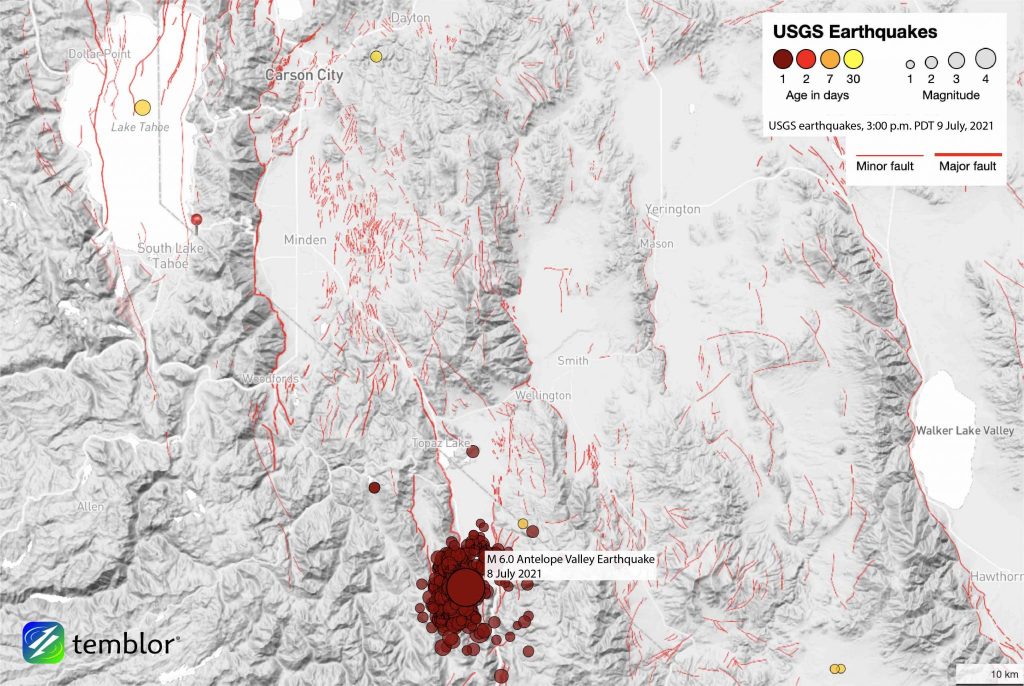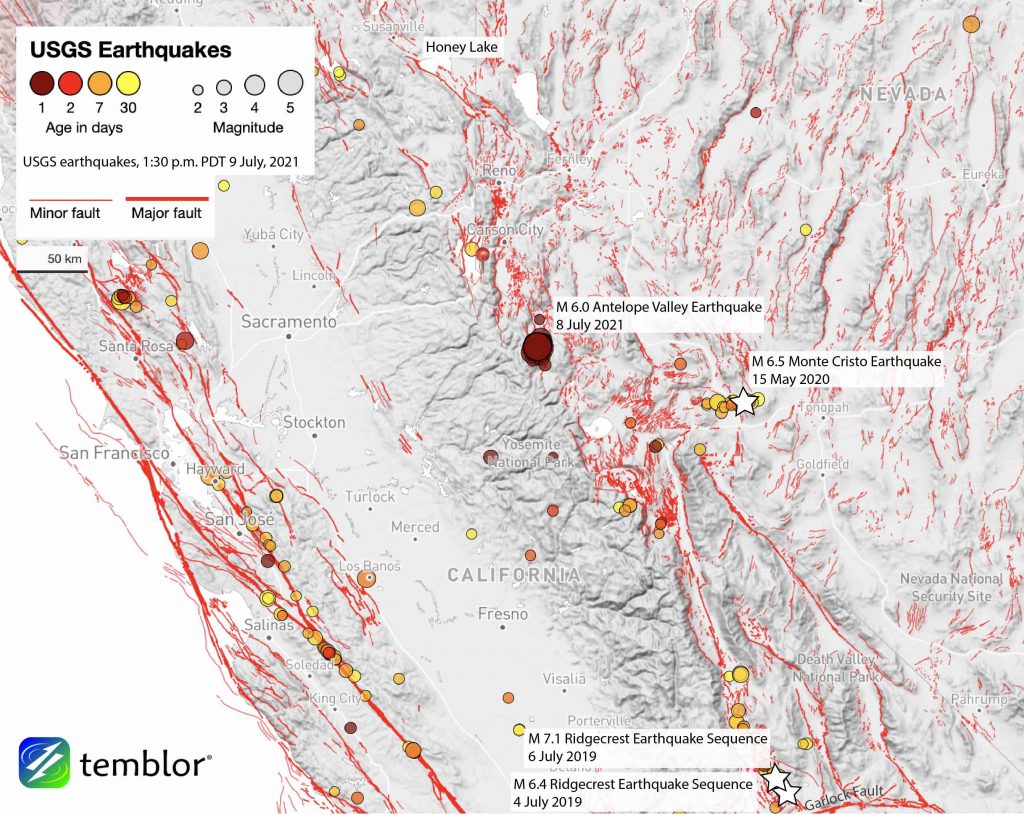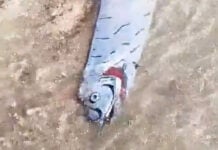On the afternoon of July 8, 2021, a M6.0 earthquake rocked much of central California and western Nevada.
Intense shaking that lasted as long as 20 seconds was reported 80 miles (~130 kilometers) away in Reno, while the Bay Area, Central Valley, Southern California and even Las Vegas all shook as well.

This earthquake originated in the seismically busy Central Walker Lane, between Yosemite National Park in California and Carson City, Nev., in the southernmost part of Antelope Valley.
In the last three years, four large earthquakes — greater than magnitude 6.0 — have struck the Walker Lane region. What’s driving all this seismic activity and what does it mean for the earthquake hazards far from the famed San Andreas Fault?
About the buy Walker Lane fault line
The Walker Lane is a diffuse zone of normal and strike-slip faults.
It follows an approximately 60-mile (100-kilometer)-wide swath along the Eastern Sierras and California/Nevada border, reaching from Death Valley and the Garlock Fault in the south to north of the Honey Lake Valley region.
The Walker Lane Fault system accommodates roughly 20 percent of the 2-inch (50-millimeter) per year right-lateral shear between the Pacific and North American Plates, while the remaining 80 percent is accommodated along the more well-known San Andreas Fault system.

The Walker Lane has been getting much attention recently, and for good reason.
In the last three years, far more moderate earthquakes have occurred along the Walker Lane Fault system than any other single fault system in the western United States.
This earthquake is the fourth event larger than magnitude-6.0 since the 2019 Ridgecrest Earthquake Sequence that included magnitude-6.4 and magnitude-7.1 earthquakes, and the 2020 magnitude-6.5 Monte Cristo Range earthquake.
In 2021 alone, yesterday’s earthquake joins a series of several other widely felt events ranging from magnitude 4 to 5 near Lake Tahoe and the Northern Sierras.
Yet, the Walker Lane didn’t start popping off events in 2019.
In 2016 the Nine Mile Ranch sequence produced three events of about magnitude-5.5 near Hawthorne, Nev., in less than an hour, following a similar sequence from 2011. In 2008, the Mogul sequence rocked Reno, Nev., with a magnitude-4.7 quake.
The largest-known Walker Lane event was the 1872 magnitude-7.4 Owens Valley earthquake, which is roughly the maximum magnitude we expect of an earthquake along any single fault in this system.
Decades of paleoseismic and tectonic studies have revealed dozens of faults throughout the Walker Lane, some with evidence of large prehistoric earthquakes that likely exceeded magnitude-7.0.
For example, the most recent earthquake along the Genoa Fault near Carson City occurred about 450 years ago. The fault running beneath the west shore of Lake Tahoe most recently ruptured about 5,500 years ago.
A tectonic mystery at the Central Walker Lane
Shifting attention to the tectonics of the Central Walker Lane where this most recent magnitude-6.0 event occurred, an unresolved tectonic mystery swirls.
Using high accuracy stationary GPS stations, we can observe — in real time — the crest of the Sierra Nevada sliding northwest at a rate of about 0.3 inches (7 millimeters) per year relative to Fallon, Nev., shearing the region spanning Antelope, Smith, and Mason Valleys.
Yet, geologically speaking, we cannot find sufficient strike-slip faulting to account for this observed shear.

While a number of hypotheses have been proposed to explain this mismatch, we expect that future large earthquakes will show complex, transient and discontinuous deformation, as opposed to long-lasting fault strands that produce the fault scarps, large offsets of features in the landscape, and other geomorphologic features we would require to measure long-term faulting rates.
This more subtle, less dramatic style of deformation was witnessed in the 2020 Monte Cristo Range earthquake, as well as other earlier Walker Lane events.
Other explanations for the missing measurable shear that we expect based on GPS data include clockwise rotations of basins and bounding normal faults, and obliquely slipping faults that bound the rangefronts of the mountains in this area.
The fault responsible for the July 8 magnitude-6.0 event produced a north-striking normal moment tensor.
Normal faulting is consistent with the local patterns of faulting in Antelope Valley. In other words, the quake occurred on a north-striking fault that moves because of east-west directed extension, similar to what we would expect for the north-oriented Antelope Valley Fault that bounds the range.
This fault does not have a significant oblique component, as one might expect if this range were accommodating right-lateral shear — the motion recorded by the San Andreas Fault, and the overall movement of the Walker Lane as recorded by GPS.

Underappreciated earthquake hazards in eastern California and western Nevada
All told, eastern California and western Nevada have much underappreciated earthquake hazards.
While these hazards are well known to the earthquake science community, the public seems to view these moderate magnitude-5 to 6 events as “the big ones” when in reality, were the inevitable magnitude-7 event to occur in one of the rapidly developing communities of the region, the losses to life and property would be devastating.
Everyone living in this region should not only keep an earthquake kit and have a plan for inevitable forthcoming quakes, but they should also make sure their homes are prepared for earthquakes.
There are a number of cost-effective measures that can be readily applied by homeowners to mitigate damage, like securing hot water heaters to walls and securing foundations.
Finally, these moderate events should serve as a warning to our community leaders, and communities should encourage business owners to retrofit the relatively large number of unreinforced masonry structures in many of the historic districts of Reno, Carson Valley, Truckee, and Tahoe.
Remember, if you feel shaking, ‘drop, cover and hold on.’ [Temblor]
Now subscribe to this blog to get more amazing news curated just for you right in your inbox on a daily basis (here an example of our new newsletter).
You can also follow us on Facebook and/ or Twitter. And, by the way you can also make a donation through Paypal. Thank you!
You should really subscribe to QFiles. You will get very interesting information about strange events around the world.













We the Iranian American and inside Iran we plea to Strange sounds that please put Iran situation room or an article about mass riots in Iran. We can put all Iran room situations that well can be come here as well. Many states are in drought and what happens in Iran and other nations can come to USA.
EREVAN, July 19 (Reuters) – Iranians facing a shortage of COVID-19 vaccines at home are travelling to neighbouring Armenia as tourists in growing numbers to get inoculated there for free, according to data from Armenia’s tourism board.
Armenia has approved three vaccines against COVID-19 – Russia’s Sputnik V, China’s CoronaVac and AstraZeneca’s vaccine and initially offered all of them free to foreign visitors.
The Armenian Tourism Committee said more than 8,500 Iranian citizens had visited in June, up from 5,000 a month earlier.
“We didn’t have any special plans to develop vaccine tourism, it happened accidentally,” said Alfred Kocharyan, deputy head of the Armenian Tourism Committee, adding that people were also coming from India to get free shots.
“But demand for vaccines has created an opportunity for our travel agencies which I encourage them to take.”
Armenian TV reported long queues of Iranians at mobile vaccination units in Yerevan, the capital of Armenia, last week with some Iranian tourists saying they had spent several nights in the street waiting for their turn to get vaccinated.
Iranian in many cities are raised up and that link in you tube is English and Farsi . Please Pass it to all Terrorist regime of Iran is falling in 1400 years of Islamic calendar which is now.
No deal with Terrorist Mullahs .
“There were too many people there, there were too many Iranians, and we still don’t know if we can get a vaccine or not,” said Shirin Darvish, an Iranian tourist who had been waiting to get a shot for ten days.
The buildup of overnight queues prompted the authorities to tighten vaccine rules.
As of July 15, foreigners can only be inoculated in Armenia with the AstraZeneca vaccine and must spend 10 days in the country before becoming eligible.
Armenia had administered at least 260,813 doses of COVID vaccines by July 10, according to the Armenian authorities.
Iran, with a population of 83 million, had recorded 87,161 deaths from coronavirus as of July 19, the highest toll in the Middle East.
According to The Islamic Republic News Agency, around 2.7% of Iran’s population have received both doses of an anti-coronavirus vaccine.
Reporting by Artem Mikryukov; writing by Maria Vasilyeva; editing by Andrew Osborn and Philippa Fletcher
I have posted this please post it. https://www.youtube.com/watch?v=vWdhbvmUc-Q it is current events in Iran and latest updates . Death to Dictator is massage from Iranian want freedom where are you Joe Biden? Long Live Trump.
i have told you many years we are doomed by many eclipses of sun and moon and full moon.
Gates of hell opens on the world last time indeed. Will continue third shaking of planet and Californians will be like Iran Khuzestan no water and people are in the streets and want one thing water and terrorist regime of Iran is sending troops to kill them.
Iran water crisis: Internet shutdowns observed amid protests in Khuzestan.
Mobile internet services in Iran have been disrupted amid ongoing protests against a water crisis in the country’s southwest.
At least three people — including a police officer — have been killed in clashes in Khuzestan, state media have reported.
Demonstrators have been calling for action to address the shortage of water in the oil-rich province for seven consecutive days.
Iran’s authorities have blamed the water crisis on a severe drought, noting that rainfall in the region has decreased by almost 50% in the last year, leaving dams with dwindling water supplies.
But citizens in Khuzestan — a province home to a large Arab minority — have repeatedly complained that they are being left behind by the Iranian regime.
Prominent lawyers have said that Khuzestan’s problem stems from the illegal theft of water from river forks in the region. Outgoing Iranian President Hassan Rouhani has described the protests as a “natural right”.
Hashtags in Farsi and Arabic such as #KhuzestanIsThirsty and #KhuzestanHasNoWater have been widely used on social media to direct attention towards the crisis and protests.
On Thursday, the internet monitoring observatory NetBlocks confirmed there had been a “significant regional disruption” to mobile internet service since last week.
Cities in the region, including Ahvaz, Ramhormoz, and Susangerd, had experienced “a severe slowing of internet service or near-total internet shutdown” since 15 July, NetBlocks said in a statement.
“[This] is likely to limit the public’s ability to express political discontent or communicate with each other and the outside world.”
The organisation added that cellular data analysis indicated the regional shutdown “intended to control protests”.
Although fixed-line and WiFi connectivity remained stable in the Khuzestan, Net Blocks noted that the area is reported to be “highly dependent” on mobile data services.
Iran has faced a series of network disruptions, including during widespread public protests against rising fuel prices in November 2019.
Please FSS in you tube kindly talk about Iran has no water. We love you all from World and strange sounds and strange sounds we love you too.
https://www.euronews.com/2021/07/22/iran-water-crisis-internet-shutdowns-observed-amid-protests-in-kh
That Sierra Nevada mountain range is gorgeous. Did some camping as a youth out there. Back around 1971. Saw the most badass fireball out there. It went through over past the horizon in a split second.
Looked like a huge rock on fire with flames. We were way high up too, so that probably had something to do with how it looked.
Did some rock climbing too. There was a slide rock into a pool of ice cold water on the climb.
Glaciers on this one 26 mile hike too. Slid down those. I think it was called Glacier Lake. There were caves too. Place was awesome. That was what people did back then for fun. You can see the entire Milky Way, and satellites orbiting at night with the naked eye.
There’s been quakes there, you can see the sides of mountains, and slip faults in the rock layers.